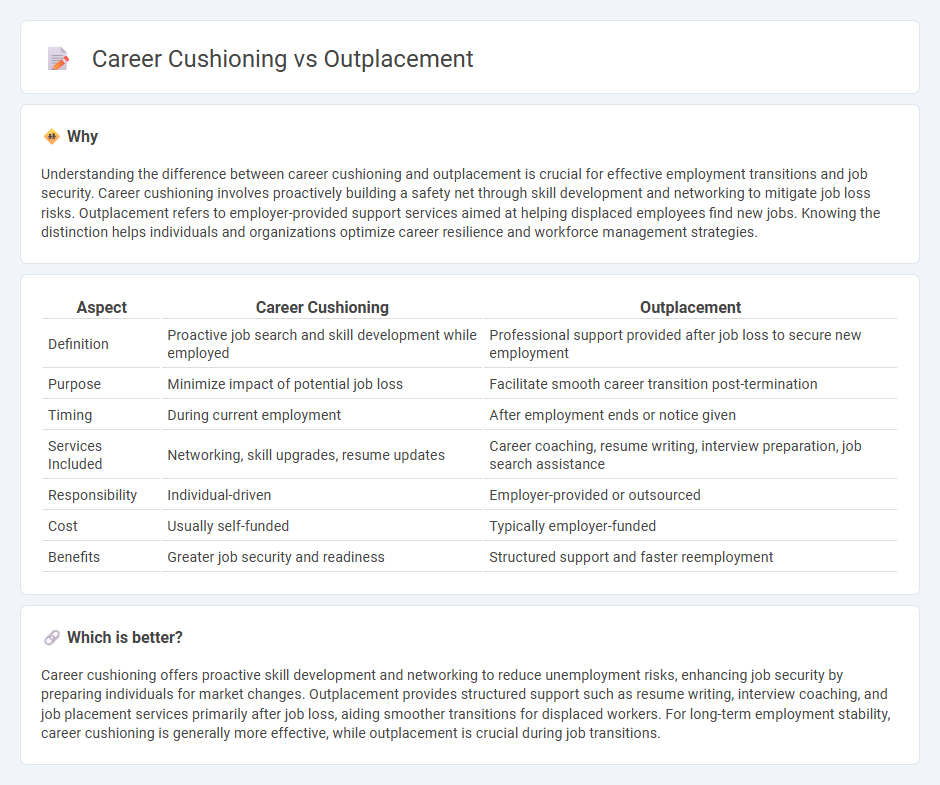
Career cushioning empowers employees to proactively develop new skills and networking opportunities while still employed, enhancing job security and adaptability. Outplacement services provide structured support, including resume assistance and job search guidance, to individuals facing layoffs or transitions. Discover more about how career cushioning and outplacement can strategically shape your professional journey.
Why it is important
Understanding the difference between career cushioning and outplacement is crucial for effective employment transitions and job security. Career cushioning involves proactively building a safety net through skill development and networking to mitigate job loss risks. Outplacement refers to employer-provided support services aimed at helping displaced employees find new jobs. Knowing the distinction helps individuals and organizations optimize career resilience and workforce management strategies.
Comparison Table
| Aspect | Career Cushioning | Outplacement |
|---|---|---|
| Definition | Proactive job search and skill development while employed | Professional support provided after job loss to secure new employment |
| Purpose | Minimize impact of potential job loss | Facilitate smooth career transition post-termination |
| Timing | During current employment | After employment ends or notice given |
| Services Included | Networking, skill upgrades, resume updates | Career coaching, resume writing, interview preparation, job search assistance |
| Responsibility | Individual-driven | Employer-provided or outsourced |
| Cost | Usually self-funded | Typically employer-funded |
| Benefits | Greater job security and readiness | Structured support and faster reemployment |
Which is better?
Career cushioning offers proactive skill development and networking to reduce unemployment risks, enhancing job security by preparing individuals for market changes. Outplacement provides structured support such as resume writing, interview coaching, and job placement services primarily after job loss, aiding smoother transitions for displaced workers. For long-term employment stability, career cushioning is generally more effective, while outplacement is crucial during job transitions.
Connection
Career cushioning involves proactively building skills and expanding networks to mitigate job loss risks, while outplacement offers structured support during employment transitions. Both strategies enhance workforce resilience by preparing individuals for career changes and facilitating smoother job searches. Employers increasingly invest in these approaches to reduce unemployment duration and maintain talent engagement.
Key Terms
Job Transition Support
Job transition support through outplacement services offers structured assistance including resume writing, interview coaching, and job search strategies to ease the shift from one role to another. Career cushioning emphasizes proactive skill development and networking to enhance employability and job security before any job loss occurs. Explore deeper insights on how these approaches can strategically support your career transition needs.
Job Security
Outplacement services provide structured support such as resume building, interview coaching, and job placement assistance to employees facing layoffs, enhancing job security through proactive career transition. Career cushioning involves discreetly developing skills, networking, and exploring opportunities while still employed, acting as a personal safety net against unexpected job loss. Explore how these strategies can safeguard your career stability and prepare you for market changes.
Severance Packages
Severance packages play a crucial role in both outplacement and career cushioning strategies, offering financial and support benefits to employees during transition periods. Outplacement services often include career counseling, resume building, and job search assistance, which are typically funded by severance packages to facilitate a smoother transition. Explore the differences and benefits of severance-backed outplacement versus career cushioning to maximize employee support during layoffs.
Source and External Links
Outplacement - Wikipedia - Outplacement is a support service typically paid for by employers and delivered by consultancy firms to help former employees transition to new jobs through practical advice, training, and sometimes psychological support.
Outplacement - What is it and What are its Benefits? | ADP - Outplacement is an employer-sponsored benefit, often part of a severance package, that assists terminated or laid-off workers with job search skills, resume writing, interviewing, networking, and salary negotiation to ease their move into a new role.
What is outplacement | Randstad Enterprise - Outplacement solutions offer certified coaching, technology resources, professional branding, customized job leads, and emotional support to help displaced employees across all levels quickly and effectively transition to new employment opportunities.
 dowidth.com
dowidth.com